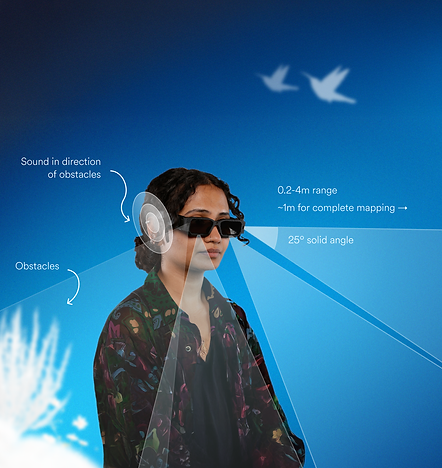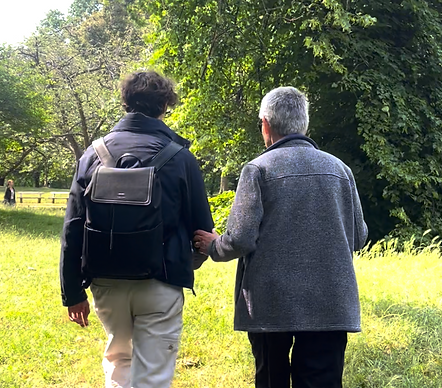
.
Problems with audio?
Try clicking here.

↓
Project origins
Building confidence to hike
through spatial
awareness
TrailSense is my capstone project as a Master's student in Innovation Design Engineering. Developed in collaboration with individuals at ONCE* and Pandetrave**, this pair of smart sunglasses empowers visually impaired individuals to join nature-based activities by enhancing the natural soundscape with directional audio cues for an added sense of spatial awareness. Using depth sensors and bone-conduction headphones, they map the environment ahead and subtly adjust ambient sounds to reflect the exact position of obstacles, helping hikers stay oriented and confident while remaining connected to nature and those around them.




In the Spanish province of León, Pandetrave organizes inclusive hikes in which visually impaired hikers can enjoy even the most challenging trails with the help of sighted guides.
Images courtesy of Pandetrave.
Design Journey
Hiking goes beyond the visual
"Itʼs [about] the sound of the birds and that of the plants as their leaves move with the wind. Itʼs breathing in the fresh air, and feeling in touch with nature"
— Manoli, Blind hiker.
While the benefits of being in nature are universal, the risks are not. For blind and visually impaired people, hiking brings unique challenges — from uneven terrain to low-hanging branches — making urban mobility tools like the white cane ineffective on the trail.
Despite these obstacles, blind hikers still enjoy group walks with sighted guides. But for many, having to rely on unfamiliar companions and the absence of their usual navigational tools can feel unsafe and discouraging.
Together with the organizations and mountaineering clubs that arrange these guided activities, Trailsense has been designed to cater to those hesitant beginner hikers, giving them the confidence and reassurance needed to get started.
Technical Challenge
Timely and directional information
We see many solutions designed to help visually impaired people navigate. However, many of these fail to get traction within the community. Why is this?
My conversations with visually impaired individuals revealed the prerequisites for a navigational aid to be truly useful: it needs to be able to provide timely and spatial information.
TrailSense was designed with these needs in mind. The selection and placement of its sensors were carefully iterated to ensure effective obstacle detection at the right range and response time. To convey the position and distance of obstacles, TrailSense uses spatial audio delivered through stereo over-ear speakers—amplifying sounds in the direction of an obstacle and increasing their intensity as the user gets closer.
But this isn't the only requirement needed to make a navigational tool suitable for hikes and nature exploration...

The sensor choice and positioning were iterated on to make sure they provide obstacle detection at the right range and time. Stereo speakers provide a spatial audio experience to indicate the direction of obstacles.

Design & Technical Challenge
Staying in nature
"When I'm out in nature, I don't want a lot of artificial sounds... these would be jarring, they would be irritating."
— Geoff, Blind hiker.
Hikers do not want technology to interfere with their experience of being in nature. Sound plays a vital role in how visually impaired people connect with and appreciate their surroundings. Any solution had to respect this sensorial relationship with the countryside—enhancing awareness without disrupting the natural experience.
TrailSense adopts a sensory-friendly approach to obstacle detection. Instead of relying on artificial beeps, it amplifies ambient sounds in the direction of nearby obstacles, making the natural environment itself louder as the user gets closer.
This is made possible by an algorithm that processes sound data captured by the glasses’ embedded microphone, isolating and enhancing background sounds to provide intuitive, non-intrusive feedback.
Tested where it matters
Beyond the lab. TrailSense is the result of field testing with blind hikers, ensuring it meets real-world needs with accuracy and care.
Acknowledgments to all the project collaborators, from ONCE, Pandetrave, TAVIP, and every individual who shared their experiences to help shape TrailSense.
